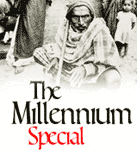The celebrated danseuse on the landmarks in Indian dance
About a hundred years ago, dance was present in every nook and corner of India even though it was not very well recognised.
Each of the presently known forms has a very long history of its technique, its sociological connotations and, of
course, its relevance to society.
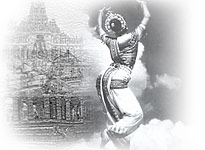 There has been a particular kind of unity in theatre art in the length and breadth of the country which has been handed down by traditional artists. The content was also more or less the same, only the language differed. The content was
either the Ramayana or Mahabharata and it was this branch of artistes who were, I would say responsible for the
ethnic cultural unity you find at the grassroot level in the Indian subcontinent. I am talking about theatre
because dance used to be a part of theatre. Of course, dance branched out as a separate form in the medieval age
itself.
There has been a particular kind of unity in theatre art in the length and breadth of the country which has been handed down by traditional artists. The content was also more or less the same, only the language differed. The content was
either the Ramayana or Mahabharata and it was this branch of artistes who were, I would say responsible for the
ethnic cultural unity you find at the grassroot level in the Indian subcontinent. I am talking about theatre
because dance used to be a part of theatre. Of course, dance branched out as a separate form in the medieval age
itself.
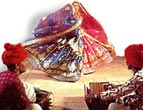 Dance was spread at various levels. One was in the court. Whether it was Orissa or Tamil Nadu or Kerala, there
was a court dance. Even in the Mughal court. There was another type of dance form for the temple, present in many parts of India. Both have a very ancient tradition. The technique of dance was
common to both the court and temple dances, but the attitude of the dancers were different. The court dancer was
expected to be a scholar and an intellectual. So there was a difference between an ordinary dancer and a
courtesan. The temple dancer, the devadasi, was a devotee, a bhakta. She did not have an intellectual but a
spiritual approach to life. A devadasi had to satisfy her own soul while she danced and offered herself or
surrendered to the lord, but the rajadasi's dance was meant to be an entertainment.
Dance was spread at various levels. One was in the court. Whether it was Orissa or Tamil Nadu or Kerala, there
was a court dance. Even in the Mughal court. There was another type of dance form for the temple, present in many parts of India. Both have a very ancient tradition. The technique of dance was
common to both the court and temple dances, but the attitude of the dancers were different. The court dancer was
expected to be a scholar and an intellectual. So there was a difference between an ordinary dancer and a
courtesan. The temple dancer, the devadasi, was a devotee, a bhakta. She did not have an intellectual but a
spiritual approach to life. A devadasi had to satisfy her own soul while she danced and offered herself or
surrendered to the lord, but the rajadasi's dance was meant to be an entertainment.
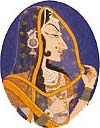 The binding force between a court dancer, a temple dancer and a folk dancer was religion. You cannot
separate traditional performing art from religion in India. For a great number of artistes in the major part of the
country, religion is very important even now. There may be isolated cases now where an artist says that art has to
be totally secular. That is the new approach of the century and this approach is not part of the Indian tradition
because art has been a way of worship. Even if the dancer performed only for the sake of entertainment, she
was also a religious person and worshipped her profession. With no exception, all the dancers thought of
Nataraja as the ultimate. Krishna also had an important position. Secular themes are presented in
dance form, but the dancer worships before performing.
The binding force between a court dancer, a temple dancer and a folk dancer was religion. You cannot
separate traditional performing art from religion in India. For a great number of artistes in the major part of the
country, religion is very important even now. There may be isolated cases now where an artist says that art has to
be totally secular. That is the new approach of the century and this approach is not part of the Indian tradition
because art has been a way of worship. Even if the dancer performed only for the sake of entertainment, she
was also a religious person and worshipped her profession. With no exception, all the dancers thought of
Nataraja as the ultimate. Krishna also had an important position. Secular themes are presented in
dance form, but the dancer worships before performing.
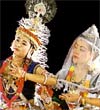 The popularity of the art has been on the increase. If you can make a graph of its respectability in society, you will
find that the curve goes up and down. Few centuries ago, it was on the rise, during the Mughal period also, it was
up but in the British India, the respectability came down. The artists were well looked after in the Mughal period
even though the format and themes were changed in their courts. Some Kathak dancers told me that a lot of
changes were done in the presentation of Kathak to suit the Mughal court because Kathak originated in the
ras lilas. In Kathak, Krishna's stories were dramatised in Vrindavan and such places. But in this century,
particularly in post Independent India, many Kathak dancers have revived the old Hindu tradition that was a
part of the dance form. They also revived old songs and dhumries are also danced now.
The popularity of the art has been on the increase. If you can make a graph of its respectability in society, you will
find that the curve goes up and down. Few centuries ago, it was on the rise, during the Mughal period also, it was
up but in the British India, the respectability came down. The artists were well looked after in the Mughal period
even though the format and themes were changed in their courts. Some Kathak dancers told me that a lot of
changes were done in the presentation of Kathak to suit the Mughal court because Kathak originated in the
ras lilas. In Kathak, Krishna's stories were dramatised in Vrindavan and such places. But in this century,
particularly in post Independent India, many Kathak dancers have revived the old Hindu tradition that was a
part of the dance form. They also revived old songs and dhumries are also danced now.
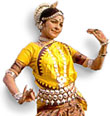 The devadasi system came to a close when the Anti Devadasi Bill was passed in the Madras assembly in 1930. This was moved in the assembly by the great social reformer, Dr Muthulakshmi Reddy, who herself hailed from a
devadasi family. That is the reason why she wanted to reform the system.
The devadasi system came to a close when the Anti Devadasi Bill was passed in the Madras assembly in 1930. This was moved in the assembly by the great social reformer, Dr Muthulakshmi Reddy, who herself hailed from a
devadasi family. That is the reason why she wanted to reform the system.
 It was Tagore who first thought of the need to make Indians proud of the Indian culture and its performing arts.
He knew that art and culture could be a unifying factor in India. He was such a deerkha darsi that in one of the dance dramas that he composed -- he has combined many -- he combined Kathakali and Manipuri. He had
Kathakali masters, Bharatnatyam masters, Manipuri masters and many such artists from various parts of India in
Shantiniketan and created a Shantiniketan style of dance. Tagore was not a dancer or a singer but a great
visionary who made it possible for letting many Indian arts live and flourish.
It was Tagore who first thought of the need to make Indians proud of the Indian culture and its performing arts.
He knew that art and culture could be a unifying factor in India. He was such a deerkha darsi that in one of the dance dramas that he composed -- he has combined many -- he combined Kathakali and Manipuri. He had
Kathakali masters, Bharatnatyam masters, Manipuri masters and many such artists from various parts of India in
Shantiniketan and created a Shantiniketan style of dance. Tagore was not a dancer or a singer but a great
visionary who made it possible for letting many Indian arts live and flourish.
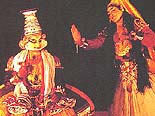 Later, Kalakshetra was started by Rukmini Devi Arundel. She was a great visionary and her name has to be written
in golden letters when you write the history of Indian dance in this century. In the same way, Vallathol, the great
Malayalam poet revived all the traditional art forms of Kerala including Kathakali. If not for him, all those art
forms would have gone to oblivion. Odissi was only rediscovered some twenty years after Independence. Now in
Assam, artists are trying to get recognition for their classical dance called Kshatriya.
Later, Kalakshetra was started by Rukmini Devi Arundel. She was a great visionary and her name has to be written
in golden letters when you write the history of Indian dance in this century. In the same way, Vallathol, the great
Malayalam poet revived all the traditional art forms of Kerala including Kathakali. If not for him, all those art
forms would have gone to oblivion. Odissi was only rediscovered some twenty years after Independence. Now in
Assam, artists are trying to get recognition for their classical dance called Kshatriya.
People like Rukmini Devi, Vallathol and Tagore have done their best to revitalise, shall we say, the common
self esteem of the Indians which was almost lost during the British regime. Anything that was part of our tradition
was thought of as something to be belittled. Anything that was a part of our culture was not respected at all. The
British rule was the worst period as far as our traditional art forms are concerned. Even during the Mughal period,
I don't think we lost our self esteem.
 Every regional discipline of dance, which was there earlier is now enjoying the status of a neo-classical format.
There is a very long history to each of these forms -- yet they are young as they were all revived and rejuvenated. And all these regional forms can be called desi. This is the term that the medieval authorities use. All these desis have a
common link called marga which means path. Desi and marga are two words that are used from time
immemorial, that is, from the time of Bharata who was the aadi guru. He was the first person to scientifically write on all dramatic forms in an encyclopedic form called the Natyashastra.
Every regional discipline of dance, which was there earlier is now enjoying the status of a neo-classical format.
There is a very long history to each of these forms -- yet they are young as they were all revived and rejuvenated. And all these regional forms can be called desi. This is the term that the medieval authorities use. All these desis have a
common link called marga which means path. Desi and marga are two words that are used from time
immemorial, that is, from the time of Bharata who was the aadi guru. He was the first person to scientifically write on all dramatic forms in an encyclopedic form called the Natyashastra.
As told to Shobha Warrier
Tell us what do you think of this list?
